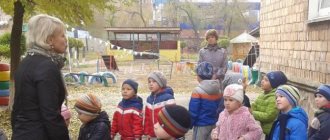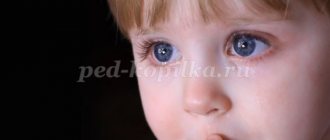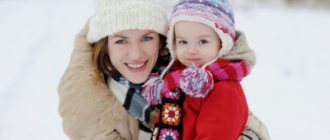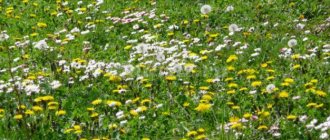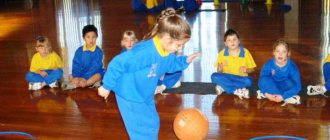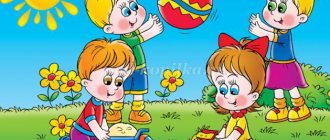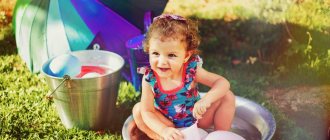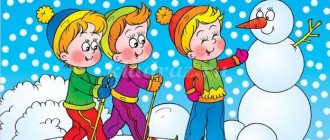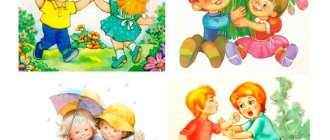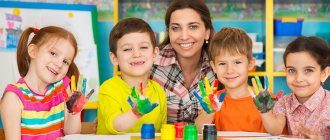Organization and methodology of walks in the summer
Author: Kravyakova Svetlana Vitalievna
Consultation for educators “Organization and methods of conducting walks in the summer”
Good afternoon, dear colleagues!
Today we are starting with you our seminar - a workshop on organizing and conducting walks in the summer.
I would like to start my speech with the statement of one pediatrician who said: “A day spent by a child without a walk is lost for his health” (G.N. Speransky)
So what is a walk?
A walk is a routine moment of children’s life activity in a preschool institution, organized in advance by the teacher, which takes place in the fresh air.
You all know well that the daily routine of any kindergarten includes a daily afternoon walk after classes and an evening walk after afternoon tea. According to
According to sanitary and epidemiological rules and regulations, the total duration of the walk is 4 - 4.5 hours.
In the summer, the kindergarten daily routine provides for children to spend maximum time in the fresh air with breaks for meals and sleep.
The time allotted for walking must be strictly observed.
But, in fact, children walk less, the duration of the walk is reduced for various reasons, and its health-improving and developmental potential is far from being fully used. Disorganization and monotony are typical disadvantages of organizing walks in kindergarten. And the pedagogical influence on a walk is often replaced by childcare.
Therefore, in order to properly organize and manage children’s activities during a walk, the teacher must expand his knowledge, possess practical skills, as well as methods for conducting a walk.
And first, let's remember what kind of walks there are.
Types of walks:
- Traditional/typical – the most free activity for children.
- Combined – targeted walk and free activity. (Targeted walk is carried out from the second younger group with exit outside the kindergarten);
- Excursion (conducted from the middle group at least once a month);
· Hiking (with children of senior preschool age).
Today at the seminar we will look in detail at the structure and methodology of conducting a traditional/or standard walk.
Proper organization of such a walk involves the use of five parts:
· Observation;
· Labor activity of children;
· Outdoor games
· Individual work with children;
· Independent activity of children.
The effectiveness of all parts of the walk depends entirely on the teacher. These components allow you to make your walk more eventful and interesting. In addition, they act not as separate pedagogical events, but as logically substantiated parts of what is planned by the teacher in a specific outing.
And now, let's take a closer look at each component of the walk.
Observations can be roughly divided into several types:
• Observations of wildlife (representatives of flora and fauna - plants, animals, birds, insects).
• Observations of inanimate nature (seasonal and weather phenomena, familiarity with the properties of water, sand, clay, natural materials - stones, shells, etc.).
• Observations of the work of adults (observations of the work of adults who work near the kindergarten are organized: janitor, driver, builder, policeman).
• Observations of street life (public, personal transport, trucks, cars, special vehicles, colorful decorations for the holidays).
At a younger age, observations should take no more than 5-10 minutes, at an older age they should range from 10 to 20 minutes. They must be carried out daily, and each time children should be offered different objects to consider.
It is very difficult to hold the attention of a child, especially one of primary preschool age. While walking, a child encounters a lot of distractions: he noticed a flying butterfly or was distracted by the noise of a passing car, and there are a lot of such distractions on the street. Therefore, observations should not be extended in time, vivid, interesting and meaningful. When planning observations, the teacher must think about: the equipment and materials that he will use during the observation, the placement of children, the teacher must think about ways to attract the attention of children (this could be: surprise moments, the use of artistic words: poetic texts, riddles, proverbs and sayings, which are perceived by children with great interest and other techniques), it is also necessary to involve the children themselves in activating mental activity (and this can be done by asking search questions and using children’s experience). The main thing in this component of the walk is not to leave children indifferent to the sight of vivid images and events in the environment.
The next important component of the walk is outdoor games.
. This part of the walk includes: 2-3 games of high mobility, 2-3 games of low and medium mobility, games of the children’s choice and didactic games are also used.
Outdoor games in the junior group - 6-10 minutes, in the middle group - 10-15 minutes, in the senior and preparatory groups - 20-25 minutes.
When choosing a game, the teacher should consider the following factors:
-time of year (weather conditions, air temperature);
-age of children (health status, desire);
- the nature of the previous activity.
The sequence of structural components of a walk may vary depending on the type of previous activity. If the children were in an activity that required increased cognitive activity and mental stress, then at the beginning of the walk it is advisable to conduct outdoor games, jogging, and only then - observations. If there was a physical education or music lesson before the walk, the walk begins with observation or quiet play.
To enhance the physical activity of preschoolers during walks, large toys, cars, and various aids are brought to the site: hoops, balls, jump ropes, badminton accessories, etc.
Here I would like to draw your attention to the fact that when conducting this part of the walk, you should strive to ensure that your children in the future learn to play outdoor games of their own free will, following the basic rules and maintaining discipline. When choosing a game for children, try to set tasks not only of a motor nature - to consolidate the skill of a particular movement, but also of a moral nature - to develop in them a sense of camaraderie, mutual assistance and collectivism.
I will not go into detail about the methodology for conducting outdoor games in preschool educational institutions, because... Galina Anatolyevna will tell us about this at one of the subsequent methodological associations.
The only thing I would like to emphasize in this part is that you do not forget to carry out didactic games and exercises in this part of the walk.
They should be short and take 3-4 minutes at a younger age, 5-6 minutes at an older age. Didactic exercises are carried out several times during one walk with the entire group of children or with part of it.
A didactic exercise can be offered to children both at the beginning and at the end of the observation, or can be woven into the course of the observation itself, for example, “Bring a yellow leaf,” “Find a tree or shrub,” etc. In didactic tasks, several tasks can be solved simultaneously: fixing the color, shape and size of objects, they can also be performed with the help of children's physical activity, for example, children are offered tasks: “One, two, three! Run to the birch tree." And then, for older children, another more difficult task is set: “How did you know that this was a birch?” etc.
Labor activity has great educational significance during a walk. Therefore, the next structural component of a typical walk is the children’s performance of labor activities
.
It is important here that for each child the tasks are feasible, interesting and varied, and in duration - do not exceed 5-10 minutes at a younger age and 15-20 minutes at an older age. To instill in children hard work and neatness, it is very important to choose the right children's equipment (rakes, shovels, scoops, buckets). In the process of carrying out work assignments, it is important for children to develop a positive attitude towards work, as well as respect for the work of an adult, a desire to get involved in the work process, and then continue to show independence and initiative.
The forms of organizing children's labor are:
Individual work assignments;
Work in subgroups;
Teamwork.
Individual work assignments are used in all age groups of kindergarten.
In the younger group, children receive individual assignments consisting of one or two labor operations, for example, taking bird food and putting it in a feeder. Then, the teacher takes turns involving all the children in feeding the birds. Or, for example, he organizes “work nearby”: he offers to collect cones, leaves, pebbles for further crafts.
In the middle group, two subgroups can work simultaneously and perform different work assignments; The only thing is that the teacher requires constant attention to the quality of the children’s work; and the teacher must ensure that the children finish what they start.
In older children, it is necessary to develop the ability to accept a work task, present the result of its implementation, determine the sequence of operations, select the necessary tools, and then independently engage in work activities (with a little help from the teacher).
Here it is important to create the right motivation for older children, explain why it is necessary to do this work today and in this particular way, and it is also advisable to diversify and brighten up monotonous activities, for example, offer to solve riddles or use other surprise moments.
The next equally important structural component of a daily walk is individual work.
Individual work
The walk is carefully planned. It can be aimed at developing the child’s speech: i.e. to practice sound pronunciation, memorize poetry, to consolidate material in all sections of the program, or you can repeat the words of a song that children learned in a music lesson for the holiday.
During walks, the teacher can also organize individual work on physical development with one or more lagging children to perform basic movements: (walking, running, jumping, jumping, exercises with balls and hoops, throwing at a target, etc.)
In the process of individual work with a child, a conversation can be held on the formation of moral qualities, rules of behavior in a children's team, or a conversation on the recommendation of a speech therapist or psychologist. Here, it is important that the child with whom individual work is being carried out understands its necessity and willingly completes the proposed tasks.
The next structural component of the walk is the independent activity
of children,
which also needs competent guidance. The teacher must constantly monitor and monitor the independent activities of children. Paying attention to each child, the teacher must constantly keep all children in sight: in order to prevent an emerging conflict in time, praise those who, on their own initiative, collected toys, put things in order on the veranda or in the area. The teacher can offer children to organize a story-based role-playing or outdoor game, entertaining tasks, outdoor toys or work equipment, etc. One of the most favorite types of independent creative games for children is construction games with natural materials: sand, pebbles, cones, etc. Therefore, teachers need to try to diversify such games and create the necessary conditions and actively use attributes and external materials. And at the same time, of course, do not forget about compliance with sanitary and hygienic requirements for the storage and placement of external material.
Briefly, I would like to say about taking a walk in the evening.
is mandatory throughout the year ,
but since the teacher is additionally busy meeting with parents, organized observation and labor activities are not carried out during the evening walk. Against the backdrop of children playing independently, the teacher can tell and show them something, communicate with one or two children on a topic that interests them, and organize individual games.
The main thing is to make sure that the children do not get bored during the walk and that all the children are busy.
If walks are meaningful and interesting, children, as a rule, go for walks with great desire and joy. For educators, a walk is a unique opportunity not only to improve children’s health, but also to enrich the child with new knowledge and impressions. comments powered by HyperComments
Work activity while walking
Instructions should be individual, specific and simple, containing one or two actions: take them to the veranda, put them in place, etc. Such elementary tasks involve children in activities in conditions where they cannot yet organize work on their own motivation. Instructions of this nature make it possible to individualize work with children: help one, teach another, support and approve another. As you gain experience in carrying out assignments, you can make their content more complex.
We definitely get involved in the work if children offer it. For example, help them with some kind of construction, thereby showing by example that it is necessary to help each other.
Initially, no more than 3 people are involved at the same time to complete the task. As the scope of skills increases, the number of children increases.
The main thing in work activity remains the condition - to achieve a result while the children’s attention is concentrated on direct actions, interest in them has not disappeared, while the children are waiting for the final result: “Bring a watering can and we will water the flowers, etc..”
In the winter, with children, before a walk, we prepare food in order to feed the birds, everyone takes part in this activity with pleasure, during walks we pour food into the feeders, and after the walk we watch from the window how the birds fly to the feeder. Such work is extended over time, but at the same time children have the opportunity to see the result of their work.
It is necessary to convince children that their direct help leads to an interesting result for everyone. For example, we shovel snow and tell the children: “Now I’ll shovel the snow and start sculpting something interesting. If you help me carry the snow, we’ll get through it faster and start building.” It is necessary to involve children in work closer to completion so that they do not lose interest. The children take buckets and begin to carry snow, from which we built a slide for the doll. After completing the work, children have the opportunity to play with the building - roll the doll down the slide. In this way, children have the opportunity to benefit from the results of their labor, which will attract them to work next time.
The knowledge of preschoolers about the work of adults should have a great influence on the formation of their correct attitude towards work. To do this, it is necessary to give children the opportunity to “touch” the work that is available to them. So, for example, you can instruct children to help the janitor clear the paths of snow, leaves, large debris, etc. Directly in work, children feel labor tension and learn its necessity in order to obtain a result, they begin to realize that hard work includes volitional effort, skill carry out the assigned task to the end, without retreating from difficulties.
Walks in December in the senior group. Card file with goals according to the Federal State Educational Standard
Winter walks in December. Senior group of preschool educational institutions
Walk #1.
Observation of seasonal changes Purpose: to form ideas about changes in nature at the beginning of winter (the night increases and the day decreases)
;
learn to distinguish the characteristic signs of the beginning of winter, recognize their signs in poems. Progress of observation What is outside the window? The house immediately brightened up! This snow lies like a carpet, the very first, the whitest! This is what the wind was whistling outside my window all night! He wanted to say about the snow and about welcoming winter. The mountain ash has also dressed up in a white festive outfit, Only the clusters at the top are burning brighter than before. The teacher asks the children riddles and talks about signs. “It flowed and flowed and went under the glass.” (Water.)
- Without arms, without legs, but he climbs into the hut.
(Frost.)
- December ends the year - winter begins.
— Warm winter to cold summer. — The sun warms in summer and freezes in winter. White, cold winter has come to earth. The forest drowned in the snow. With the onset of winter it became even colder than in autumn. The sky is almost always covered with clouds. It's not raining, but snowing. Snow covered the ground, roofs of houses, tree branches. Streams, wild rivers, lakes were frozen in ice. The more snow falls on the ground, the better the plants will grow. Snow protects them from frost. The days are getting shorter and the nights are getting longer. The teacher asks the children questions. What month does December follow? What time of year is November? How has the general appearance of the site changed compared to autumn? Why do they cover tree roots with snow? How do people dress in winter and autumn? Work activity: Covering tree roots with snow. Goal: to cultivate a desire to help living objects. Outdoor games: “Hit the hoop”, “Running in pairs” Goal: continue to teach how to run in pairs, throw snowballs at the target. “Ice carousel” Goal: to strengthen each other’s sledding skills. “Lay it out yourself” Goal: laying out a design according to plan from plastic corks. Individual work: Sliding exercises Purpose: to learn to slide along ice paths from a running start. Independent activity of children with external materials.
Walk No. 2.
Bird watching in winter Purpose: to form an idea of the life of birds in winter; cultivate a desire to take care of birds, highlighting signs of living things. Progress of observation No paths are visible in the forest, Bushes stand in sheepskin coats. The sleeping beetles and larvae were covered under the bark by the snowfall. Fly, birdie, to people And quickly hide outside the window, And we will feed you Crumbs of bread, millet. What birds do you see near your home in winter? Why do they fly to human habitation? Why do people set up bird feeders in winter? Why do wintering birds need to be fed? Do many birds come to our feeders? What kind of food do they eat more readily? What else did you see while watching the birds at the feeder? Is there a feeder near your house? Labor activity: Clearing the area of junior preschoolers from snow. Goal: to cultivate a desire to help younger people. Outdoor games: “A clever couple” Goal: to develop the eye, achieving a good result. “Hit the target” Purpose: to teach to follow the direction of a flying object, calculate and perform movements. “Frost - Red Nose” Purpose: to teach how to deftly and quickly run across the site; Drawing “Snow Artist” Paints can be splashed on the snow and then molded from it. Or spray ready-made figures. Or just draw a picture directly in the snow. Goal: to develop creative imagination and creativity Individual work: Throwing snowballs into the distance and at the target. Goal: to develop coordination of movements. Games at the request of children
Walk No. 3.
Observing the state of nature Purpose: to teach to see beauty, to distinguish the characteristic signs of winter, to recognize them in literary texts and poems; strengthen the ability to perceive descriptions of patterns on the window. Progress of observation An amazing artist visited the window, An amazing artist painted the window for us: Palm trees, ferns, maples - there is a dense forest on the window. Only white, not green, all shiny, not plain. There are flowers and leaves on the glass - everything sparkles, everything is white. But the glass was painted without paints and without a brush. A wonderful artist visited the window. Guess, guys, who painted the window? (Frost.)
It got very cold overnight.
It was a frosty morning. Some amazing drawings appeared on the glass overnight. The snow pattern on the windows is beautiful both on a sunny day and on a cloudy one. Why do snow patterns appear on the window? How does frost depict them? Transparent water vapor that is always in the air. It is also present between the frames. Warm water vapor settles on the cold glass of the windows and turns into ice crystals, connecting with each other. Ice floes cluster on uneven surfaces, on barely noticeable scratches in the glass, and an ice garden with unusual flowers gradually grows on the window. Labor activity: Collect snow in a pile for buildings. Goal: to develop teamwork skills; cultivate the desire to achieve results Outdoor games: “Don’t stay on the floor”, “Counter dashes” Goal: continue to teach how to run and jump without bumping into a friend. “Bears and Bees” Purpose: to teach how to “pass” over an obstacle Games at the request of the children
Walk No. 4.
Observation of a sparrow Goal: to continue to consolidate knowledge about the wintering bird - the sparrow; to form an idea of the characteristics of bird behavior in winter; Learn how to keep your bird feeder clean. Progress of observation A sparrow in a brown coat was jumping, Small in stature, but fighting, It’s not easy for him in the winter. He jumps at the porch - Feed the young man. Look how many birds have flown into our dining room. What are the names of the birds that stay with us for the winter? (Wintering birds.)
How do migratory birds differ from wintering birds?
(Wintering birds have feathers and a very hard beak.)
What birds do not fly away from us for the winter?
(Sparrows, jackdaws, magpies, woodpeckers, crossbills.)
What do sparrows eat in winter?
(Crumbs, grains.)
Why do wintering birds need to be fed?
(They don’t have enough food, but being full gives the birds warmth.)
Tell us about your observations of the behavior of sparrows in winter.
(Having ruffled, they hide their beak under their wing, thus protecting themselves from frost.)
Why do sparrows settle next to humans?
(To feed and keep warm near it.)
Before putting on the food, what needs to be done?
(Clear the place for food from snow.) Labor activity: Clearing the path to the feeder Purpose: to teach how to take care of birds. Outdoor games: “Two Frosts”, “Horses” Purpose: to teach how to perform characteristic movements according to the content of the game; develop agility and speed. “Race” Goal: to develop agility, endurance and speed Individual work: “Who’s next?” Goal: practice throwing snowballs with your right and left hands in a certain direction. Games at the request of children
Walk No. 5.
Observing the work of the janitor Purpose: to continue monitoring the work of the janitor; improve vocabulary; develop a desire for order and cleanliness; instill a love of nature, a thrifty and caring attitude towards the environment. Progress of observation What does a janitor do in the kindergarten area in winter? What tools does a janitor need at this time of year? How can a street sweeper help trees in winter? The first snowball of winter lies like white fluff. The first light frost is cheerful and invigorating. Labor activity: Collecting snow to build a slide for a doll Purpose: to teach how to work together, achieving the task through joint efforts. Outdoor games: “Two Frosts”, “We are funny guys” Goal: teach clearly, pronounce the text in the game, follow the rules of the game. “Jumping on one leg” Purpose: to teach how to push off energetically and land correctly. Drawing in the snow - invite children to draw with a stick in the snow Purpose: to learn to fill the outline with colored water; develop imagination, maintain interest in drawing and creative activities. Individual work: Consolidating skiing skills Purpose: to teach how to go down a hill. Games at the request of children
- teach children to find activities of interest.
Walk No. 6.
Observation of the vegetable garden Purpose: to introduce seasonal changes in the vegetable garden in winter; cultivate interest in research activities. Observation progress Father, our vegetable garden! I bow to you with love - You feed us for a whole year And cabbage and carrots. Treat us to zucchini, celery and onions. What has changed in the garden with the arrival of winter? (Everything is covered with snow.)
What is snow for plants?
(A blanket that saves you in the cold and wind.)
If there is a lot of snow in the garden, is it good or bad.
(Okay, a lot of moisture.)
Does the snow lie evenly in different parts of the garden?
(No.)
Where is there more snow - near the building or in the center?
(Near the buildings)
.
Why? (Gusts of wind blow snow from the center to the building.)
Research activity Measure the depth of snow with a snow gauge in different parts of the garden.
Determine the condition of the soil in winter. Labor activity: Clearing paths of ice and snow Purpose: to consolidate skills in working with a shovel; cultivate perseverance and independence. Outdoor games: “Traps with a ball” Purpose: pass the ball, precisely matching the movements with the rhythm of the spoken words. “Roll to the target” Goal: to develop coordination of movements. “Entertainers” Purpose: to teach how to clearly pronounce the words of the game; learn to play by the rules. Modeling from snow “Treats for tea” Purpose: to teach children to collectively do work, distribute tasks, sculpt large figures from snow (sweets, pies, cupcakes, etc.)
- develop imagination, cultivate responsibility for a common cause.
Individual work: Development of movements Goal: to practice jumping on two legs moving forward at a distance of 2-3 m. Games at the request of children
- to teach children to find activities of interest.
Walk No. 7.
Observing changes in the kindergarten area Purpose: to teach to observe changes around us. Observation progress Santa Claus is walking along the street, Frost is scattered on the branches of birch trees. He walks, shakes his white beard, stomps his feet, only a cracking sound comes. Look how much snow there is in the garden. People say: “The more snow in winter, the better the harvest in autumn.” Guys, why do we clear the paths of snow and dump it on the beds, under the trees? Snow is a blanket for the earth. Why did we hang the feeder in the garden plot? Spring will come and the birds, as a sign of gratitude for the fact that we fed them in winter (seeds, cereals, crumbs)
, will eat the pests in our garden.
Work activity: Shoveling snow in the area for trees Goal: to cultivate a caring attitude towards nature. Outdoor games: “Snow Carousel” Purpose: to practice orientation in the area. “Homeless Hare” Purpose: remember the rules of the game; “Steeplechase” Goal: develop agility, endurance, speed Coloring crafts made from snow Goal: teach children to paint sculpted figures with colored water Individual work: Jumping on one leg Goal: teach to push off energetically and land correctly. Games at the request of children
Walk No. 8.
Observation of the wind Purpose: to expand and deepen knowledge about inanimate nature; develop interest in natural phenomena. Progress of observation The wind blew all night, the spruce trees rustled, the water wrinkled. The old pines creaked, the willows bent by the pond, howled, blew, howled. And when dawn came, it was as if there was no wind, as if it had never existed. What is the weather today? (Cold, windy, cloudy.)
What is windy snow called?
(A strong wind with snow is called a blizzard, a weak wind with snow is called drifting snow.)
From which direction is the wind blowing today?
How did you determine? (Today the wind is south, determined using a compass.)
How is wind formed?
(The sun heats the air unevenly, somewhere warmer, somewhere colder. Warm air rises up, and cold air goes down. This movement of air forms the wind.) Labor activity: Construction of snow buildings Goal: to develop skills in working with a shovel, to work together Outdoor games: “Frost Red Nose” Purpose: to teach how to deftly and quickly run across the “Snowdrome” playground Purpose: to monitor the relationships of children in the process of independent activity with the sled “Hares and the Wolf” Purpose: to teach children to follow the rules of the game Individual work: “Pair running” » Goal: to develop children in running in pairs. Independent play activity.
Walk No. 9.
Observing domestic animals in winter Purpose: to consolidate knowledge about the life of domestic animals in the winter season; to form the idea that a person takes care of domestic animals (prepares food, prepares food, cleans the home)
.
Progress of observation I love pets very much: I feed them, take care of them and caress them. I consider a dog and a cat, a goat and a pig to be my friends. Our helpers are a cow, a ram and a dark-maned black horse. They live next to us, attached to us, trusting, peace-loving. What pets do you know? How has the life of pets changed with the onset of winter? Why did they stop turning animals out to pasture? How do people care for their pets? Tell us about your observations of the life of pets in winter. Compare how domestic and wild animals live in winter. How does the life of domestic animals differ from wild animals in winter? Why do people raise pets and treat them with care? Labor activity: Clearing the path to the feeding trough Goal: improve the ability to use a shovel to clear snow. Outdoor games: “Bears and Bees” Purpose: to teach how to “pass” over an obstacle. “Owl” Purpose: to teach how to perform movements on a signal. Individual work: Performing exercises to maintain balance Goal: to develop coordination of movements. Games at the request of children
Walk No. 10.
Observing the pedestrian path Purpose: to develop knowledge about the pedestrian part of the road, traffic rules. Progress of observation: Go out with the children to the pedestrian part of the road and ask them where pedestrians are supposed to walk? Remember that you need to stick to the right side, so as not to collide with or go around oncoming people, turning to the side. Remind them that they should walk along the street at a calm pace and cross the road only when the traffic light is green. Bring the children to the crossing, ask how they knew that there was a pedestrian crossing across the road? That's right, because there is a "Pedestrian Crossing" sign and wide white stripes are drawn on the road. Labor activity: Clearing the area of snow Goal: to cultivate a desire to collectively improve your area. Outdoor games: “Hit the target” Purpose: learn to throw the ball at the target, develop accuracy, follow the rules of the game. “Sketch a tree” Goal: to consolidate the ability to draw a variety of trees in the snow. Individual work: Development of movements Goal: to consolidate the ability to move with an extended step. Games at the request of children
- teach children to find activities of interest.
Walk No. 11.
Observing snowfall Purpose: to form an idea of the properties of snow; consolidate knowledge about the seasonal phenomenon - snowfall. Progress of observation Snow flew out of the cloud and wanted to lie down on the ground. Looking for a place, he won’t find it. He lingered at the gate. White snowflakes fall, lie on the ground, on the roofs of houses. Snowflakes look like white stars. You can catch them and examine them, but you cannot breathe on them. Sometimes they fall together and fall to the ground in large flakes. Sometimes a cold wind breaks the white stars, turning them into fine snow dust. Snowflakes form in clouds from small ice crystals. In winter, they descend like sparkling stars to the ground and cover it with snow. In the cold, the snow creaks underfoot. These are the rays of snowflakes breaking. Snow is a lot of snowflakes. Why does the snow squeak? Where do snowflakes form? Why? What does snow feel like? When is snow wet and when is it dry? Which snow is easier to sculpt from? Why? What is snow? Draw attention to the falling snow. Reach out your mittened hand and catch a few snowflakes. Consider them (size, find the same ones)
.
What do snowflakes look like? What will happen to a snowflake if it lands on your bare palm? Why? Labor activity: Cleaning the area from snow Purpose: to teach how to collect snow on a stretcher, pour it into a certain place. Outdoor games: “Geese-swans”, “Who will jump better?” Goal: continue to learn how to correlate your own actions with the actions of the participants in the game; strengthen the ability to jump. Modeling from snow “Funny Snowmen” Purpose: to teach children to plan their work, place snow balls in a certain sequence; Individual work: “Hockey” Purpose: learn to roll the puck to each other in pairs. Games at the request of children
Walk No. 12.
Observing the spruce on the site Purpose: to clarify knowledge about the differences between a natural spruce and a toy spruce. Observation progress New Year's days, Frosty, stinging snow. The lights came on on the fluffy Christmas tree. The painted ball swayed, the beads rang. Why is spruce classified as a conifer? What is the main characteristic of coniferous trees? Compare the trees, what are their differences? Which tree is artificial? How do you know which tree is alive? A living spruce grows on the site, in addition to the trunk, branches, needles, it has large roots, with the help of which the tree receives moisture and nutrients from the ground and is firmly held in one place. The toy Christmas tree is small, inanimate, made of artificial material (plastic)
, it has no roots, it does not grow.
Guys, New Year is coming! It is celebrated near a decorated Christmas tree. And it would be very good if on this holiday you had an artificial Christmas tree at home, and not a live one. After all, if a Christmas tree is cut down, it will wither, die, and there will be no Christmas tree in the forest. And the artificial Christmas tree is also very beautiful, and if you decorate it, it will bring no less joy to the New Year. Labor activity: Clearing snow feeders, feeding birds Goal: to cultivate a positive attitude towards work Outdoor games: “Dog and Sparrows”, “Sledding” Goal: to practice running in different directions. the ability to navigate in space, quickly run to the sled and sit on it. Drawing “My New Year Tree” - continue to introduce children to the profession of a designer; offer to come up with and draw original decorations on the Christmas tree with colored water. Individual work: Development of movements Purpose: to consolidate the ability to run at speed; Independent play activity.
Walk No. 13.
Monitoring the roofs of houses Purpose: to provide knowledge that caps of snow can be dangerous for humans (if they fall from the roof - injury)
, obey safety rules, and be able to anticipate danger.
Observation progress : Examine the roofs of the houses. Discuss with your children how this or that situation can be dangerous. Why are icicles or icy lumps of snow that are thrown from the roof dangerous? How can you do the right thing, how can you protect yourself from danger? Ask children to think about what precautions they can take to warn others about dangerous areas. Together we come to the conclusion that such areas need to be fenced off. Come up with different types of fencing: rope with red flags, wooden or metal barriers, shields or fences. RULES! Remind children that under no circumstances should they: - Play where icicles hang from the roof or snow may fall! - Come up and touch the hanging icicles! - You can’t suck or eat icicles! - Don’t throw an icicle or snow! - Be careful and observant! - Know how to anticipate danger in advance and avoid it! - In addition to your own safety, take care of the safety of others (for example, take children by the hand and take them away from a dangerous place)
!
Labor activity: Cleaning up toys on the site Goal: to form in children the habit of carefully collecting toys after a walk Outdoor games: “The deer has a big house” Goal: to consolidate the ability to correlate movements with text. “Cat and Mice” Purpose: to teach to follow the rules of the game. “Snake” Goal: to develop children in running Individual work: “Brave guys” Goal: to practice fast running Independent play activity.
Walk No. 14.
Observing public transport Purpose: to consolidate knowledge about public transport, know the rules of the road; cultivate interest in technology and adult work. Progress of observation Buses, trolleybuses, cars and trams Run, run through the streets, overtaking each other. A traffic controller is a traffic light, like a conductor in an orchestra. He will indicate who to go and who to stand still. A collision can be avoided and a collision can also be avoided - At the intersections of all roads, our traffic light will help. I am friends with traffic lights, I am attentive, I don’t go to red lights, I wait for green ones. What public transport do you know? What is the name of the place where the buses stop? (Stop.)
Besides buses, what other cars stop at the stop?
(Minibuses, taxis.)
Which bus door should you enter?
(To the hall.)
Which door should you exit from?
(From the back.)
On which side should you go around the bus?
(Behind.)
Why?
(Transport moving along the road is clearly visible.)
You are sitting on the bus, there are no empty seats, an elderly man entered and stood next to you.
What will you do and why? How should you cross the road? (Slowly, with an adult, first look to the left and then to the right.)
What is the traffic light?
(On green.) Labor activity: Clearing paths from snow Goal: to cultivate diligence, the desire to work together. Outdoor games: “Fox in the chicken coop”, “Planes” Purpose: to practice running, the ability to act on a signal from the teacher, and jumping off a bench. “Make a picture” - make a car out of sticks - development of fine motor skills. Individual work: “Bring the bag” Purpose: to practice balance. Independent play activity.
Walk No. 15. Observing the properties of snow
Protective properties of snow.
Place jars with the same amount of water: on the surface of a snowdrift, bury shallowly in the snow, bury deep in the snow. Observe the condition of the water in the jars. Discuss with the children the importance of snow cover for plant life (it is warmer in a snowdrift, so you need to cover the roots of trees and shrubs with snow)
.
Labor activity: Collecting snow to build a winter town Goal: improve work skills, the ability to work together. Outdoor games: “Who is faster along the track?” Goal: learn to perform series jumps and sideways jumps. “Jumpers” Goal: teach jumping on two legs with moving forward 2-3 m. “Sly Fox” Goal: start the game at the teacher’s signal Let’s make crafts from snow Goal: Teach children to act in concert, select objects for making parts and decorating figures. Individual work: Improving running technique (naturalness, ease, energetic push-off) Goal: to develop coordination of movements. Games at the request of children
Walk No. 16.
Observing a blizzard Purpose: to give an idea of the movement of snow in windy weather. Progress of observation I walk in the field, I fly in freedom, I spin, I mutter, I don’t want to know anyone. I run along the snow, sweep up snowdrifts. (Blizzard.)
What do you think a blizzard is?
(Moving snow under the influence of strong winds from one place to another.)
Look carefully, what happens to the snow?
(Snow moves in the direction of the wind.)
Why do snowdrifts appear during a snowstorm?
(Snow moves from one place to another and lingers where there is an obstacle, so snowdrifts form.)
Do you think a blizzard is good or bad?
(The roots of trees are exposed - they can freeze, snow is blown away from fields and beds, impassable snowdrifts appear, you cannot go for a walk.) Labor activity: Raking snow under bushes and trees; clearing paths and slides Goal: to instill a desire to help trees and bushes shelter from frost, to work in small groups amicably and cheerfully. Outdoor games: “Frost-red nose”, “Walk in a circle” Purpose: to teach how to deftly and quickly run across the site; go around the track a full circle and return to the flag. Individual work: “On a long path” Purpose: to teach how to run in the snow and slide along an icy path as far as possible. Independent play activity.
Walk No. 17.
Observing a frosty sunny day Purpose: to form in children an idea of winter; Progress of observation The days have become shorter, the sun shines little, now the frosts have come, and winter has come. On a sunny day, pay attention to the beauty of the winter landscape (it’s white and light all around, the snow sparkles in the sun, the sky is blue)
.
Note what kind of sun it is (dim, bright, covered by clouds)
.
Remember what it was like yesterday. Draw the children's attention to the fact that in winter the sun does not warm, does not rise high, and its path becomes shorter. Draw conclusions that the sun rises later and sets earlier, because of this the day is getting shorter. In January, the days are noticeably longer, but it is getting colder. Labor activity: Covering tree trunks on the site with snow so that they do not freeze out Purpose: teach to work together; cultivate hard work. Outdoor games: “Who needs the flag?”, “Relay race with hoops” Purpose: to practice jumping forward, climbing into a hoop; cultivate dexterity and determination. Individual work: “Frisky bag” Purpose: to practice jumping on two legs.
Games at the request of children - teach children to find activities of interest. Walk No. 18.
Observing snowflakes Purpose: to pay attention to the fact that snowflakes come in different shapes; teach comparison, develop cognitive activity. Progress of observation What kind of through stars are there on the scarf and sleeve? All through, cut out. The star spun in the air a little, sat down and melted. And if you take it, water in your hand? On my palm. Watch the snow, what is it like? Look at your mittens, what kind of snowflakes are there? Pay attention to the beautiful cut out snowflakes and their different patterns. Why are snowflakes cut out? Why do they melt on the palm of your hand? Find two identical snowflakes. (No two are the same.)
Observe where the snow melts faster—on your mitten or your hand.
Why? What is formed from snow? Labor activity: Shoveling snow into a certain place for buildings Purpose: to teach to work together; cultivate hard work. Outdoor games: “Two Frosts”, “Wolf in the Moat”, Walking “snake” between objects Purpose: to teach how to perform actions on a signal without bumping into each other. Fun game “Snow Circles” Purpose: to teach children to draw circles in the snow in different ways (with sticks, trampling lines with their soles, colored water)
- to improve children’s ability to draw various lines, to develop the eye, the ability to navigate in space, on a plane.
Individual work: Elements of hockey Goal: learn to roll the puck in a given direction, roll it into the goal. Games at the request of children
Walk No. 19.
Weather observation Goal: to continue to expand and deepen our understanding of the sun in winter conditions; develop interest in inanimate objects of nature. Progress of observation Oh, winter beauty! She whitewashed all the forests, swept up mountains of snow, and invited us to ride. Winter led over us with snow sleeves with snow sleeves and scattered snowflakes on the fields and forests. We will ride down the mountain, and that’s why we really, really like winter! What has changed in nature? What is the earth covered with? What lies on the tree branches? What do trees do in winter? Labor activity: Clearing the area and paths of snow Goal: to cultivate hard work, the desire to complete the work started. Outdoor games: “Counter dashes”, “Hit the hoop” Purpose: to increase the motor activity of children during a walk; develop accuracy, agility, endurance. “Burners” Purpose: to develop dexterity, running speed, attention Drawing with colored water “In the blue sea, in white foam” Purpose: to teach children to finish drawing various objects on the snow with a stick based on a blank from a complex of geometric shapes, to paint them with colored water. Individual work: Development of movements - learning to navigate the area; - find a hidden object using a verbal description. Independent play activity.
Walk No. 20.
Observing a snowplow Goal: expand the understanding of the role of machines in performing labor-intensive work, the features of their structure; cultivate interest in technology and respect for the work of adults. Progress of observation What kind of daring janitor shoveled snow on the pavement? (Snowblower.)
A snowblower has a large scraper attached to the front.
Furry round brushes rotate in the middle between the front and rear wheels of the truck. What are they made of? (Made of steel wire.)
What kind of bristles do they have?
(Hard, prickly.)
And here’s another car coming to clear the snow.
What does she have? (Two large screws.)
What do these screws do?
(They grab the snow like a meat grinder and carry it under the blades of a fan, which throws the snow far to the side.)
What is the name of this machine?
(Snowplow.)
How are all cars alike?
What type of vehicle is a snowplow? (To a special one.) Labor activity: Feeding birds in the kindergarten area Goal: to cultivate love, careful and caring attitude towards wintering birds. Outdoor games: “Traps”, “Homeless Hare”, “Don’t Get Caught” Purpose: to exercise the ability to run without bumping into each other; develop agility and endurance. Individual work: “Knock down the flag” Purpose: learn to throw snowballs at a target; develop accuracy and attention. Independent play activity.
Walk No. 21.
Observing the sun Purpose: to continue to introduce natural phenomena, to give the concept of one of the signs of winter - frost; develop interest in inanimate objects of nature. Progress of observation Where are you, sun, really? We're completely numb. Without you, the water froze, Without you, the earth froze. Come out, sunshine, quickly! Caress and warm! Who noticed which direction the sun is in the morning? That's right, at sunrise, the sun rises there, and in the evening it will be in the other direction - in the west, where the sun will hide at night. In winter, the sun shines, but does not warm, it rises late and goes to bed early. The days in winter are short, the nights are long. In summer the sun warms, in winter it freezes. In winter, the sun smiles through tears. Labor activity: Shoveling snow into a certain place to build ice figures Purpose: to teach to work together, to achieve a goal with common efforts. Outdoor games: “Empty space”, “Make a figure” Purpose: to teach how to perform actions on a signal, without bumping into each other. “Snowball Traps” Goal: to develop motor skills in children; develop children in running and agility. Individual work: Elements of hockey Goal: learn to roll the puck in a given direction, roll it into the goal.
We recommend watching:
Consultation for parents in kindergarten. Walks in winter Walks in the middle group. December. Card index with goals according to the Federal State Educational Standard. Winter Walks in January in the middle group. Card file with goals for the Federal State Educational Standard Walking in the middle group. February. Card index with goals according to the Federal State Educational Standard. Winter
Similar articles:
Winter experiences and experiments for children
